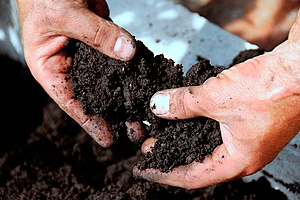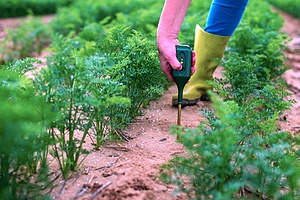 Acidic soil is soil that has a pH below 7. Soil that falls at a 7 on the pH scale is considered neutral, while anything that falls above a 7 is considered alkaline. For gardeners and non-gardeners alike, it is helpful to understand what makes soil acidic and how the pH level of soil can impact your lawn or garden.
Acidic soil is soil that has a pH below 7. Soil that falls at a 7 on the pH scale is considered neutral, while anything that falls above a 7 is considered alkaline. For gardeners and non-gardeners alike, it is helpful to understand what makes soil acidic and how the pH level of soil can impact your lawn or garden.
You can find out if your soil is acidic and take action to control the pH level if desired. The following is a complete overview of what acidic soil is, including insights into what makes the soil acidic, how to determine your soil pH and what you can do to manage your soil’s pH level.
Soil and pH Scale
All soil has a pH level. This level notes the acidity (or lack thereof) of the soil. The pH scale runs from 1 to 14. The closer the pH level is to 14, the more alkaline the soil is. Lower pH numbers represent more acidic soil. Of course, the pH scale does not only apply to the soil, and is used for just about anything.
Many consider the ideal pH level for soil to be between 6 and 7.5. This is because the phosphorus in the soil is most soluble at this pH range, which allows plants to grow better. Soil that is too acidic (closer to a 1 pH) or not acidic enough (closer to a 14 pH) may lead to issues when used.
What Makes Soil Acidic?
It is best to try and keep your soil between 6 and 7.5. To do so, it is important to understand what makes the soil more acidic. There are three main ways soil can become more acidic, which are:
- Organic matter and minerals – Organic matter refers to carbon-based compounds and minerals. This could come from organisms, proteins, nucleic acids, carbohydrates and other biological sources.
- Leaching from too much rainfall – Leaching refers to excessive loss of plant nutrients. Leaching can also lead to more acidic soil, and it most commonly occurs after heavy rainfall or as a result of too much irrigation.
- Organic fertilizers that are high in nitrogen – some plants may benefit from nitrogen fertilizer; however, overuse of nitrogen-based fertilizers can cause the fertilizer to become too acidic.
Every homeowner should assess potential threats that may make their soil more acidic. This may include improper water runoff that leads to flooding or too much use of nitrogen fertilizers, among other possible threats.
What is The Optimum Acidity for Dirt?
 The ideal acidity for soil is between a pH level of 6 and 7.5 on a scale from 1 to 14. This indicates soil that is either neutral, slightly acidic, or slightly alkaline. Ideally, it is best to keep your soil slightly acidic rather than more alkaline for proper plant growth.
The ideal acidity for soil is between a pH level of 6 and 7.5 on a scale from 1 to 14. This indicates soil that is either neutral, slightly acidic, or slightly alkaline. Ideally, it is best to keep your soil slightly acidic rather than more alkaline for proper plant growth.
With that said, all plants are different. Some plants (including most vegetable plants) grow well when the soil pH level is higher. Other plants grow well with more acidic soil. Examples of plants that grow well in acidic soil include strawberries, blueberries, azaleas, and foxgloves.
Many homeowners strive to keep the pH level of their soil balanced to avoid excessive weed growth. Many weeds grow well in acidic soil, and keeping the soil between the 6 and 7.5 pH range is a great way to fight off ugly, hard-to-remove weeds in your lawn.
How to Test Your Soil Acidity
There are several different methods you can utilize to test the pH of your soil. The most effective method is professional testing. You can take a sample of your soil and send it to your local cooperative extension office for testing. This is a great option, particularly for those who are also interested in knowing the nutrient levels and other information about their soil.
Homeowners can also test their own soil with a DIY soil-testing kit. They are relatively simple to use and can provide an accurate pH level for your soil, although they will not give as detailed a report as professional testing might.
If you do not want to spend any money at all, there are two main strategies you can use to try to see how acidic your soil is. The first is a vinegar test. With this test, you can simply add vinegar to your soil. If it fizzes, your soil is most likely alkaline. If it does not fizz, the soil is probably more acidic.
The second free testing method is to examine the weeds (or lack thereof) that are in your yard. Many weeds are more likely to grow in acidic soil. The most common types of weeds that grow in acidic soil include buttercup, dandelion, horsetail, plantain, sorrel, and silvery cinquefoil. The existence of these weeds indicates the soil is most likely acidic.
What You Can Do to Change Soil pH Levels
 You should check your soil pH levels once every couple of years. This lets you know if there is a need to change the pH levels. Also, it is helpful to have an understanding of the type of soil your plants grow best in. Some plants grow better in acidic soil, whereas others may thrive when the pH is higher.
You should check your soil pH levels once every couple of years. This lets you know if there is a need to change the pH levels. Also, it is helpful to have an understanding of the type of soil your plants grow best in. Some plants grow better in acidic soil, whereas others may thrive when the pH is higher.
If you need to make your soil less acidic, you can do so by reducing rainfall and discontinuing the use of fertilizers, among other methods. More commonly, you may need to make your soil more acidic. This can be accomplished by using nitrogen fertilizer as directed by the manufacturer and ensuring the soil receives enough water regularly.
Contact The Soil Experts
Call the soil experts at Dirt Connections today for more information. We offer high-grade bio-mix soil, and can even arrange a delivery of quality soil directly to your home. If you have any questions, our professional team is glad to answer them and ensure you have all that you need to keep your lawn and garden looking great and thriving throughout the year.
Summary

Dirt Connections was started with one goal in mind: providing quality residential and commercial construction services to clients on time and on budget. Reach out for more information on how we can support your next project.
For your convenience our estimates are free and by appointment. Call 703-940-9949 for a free estimate today!









































